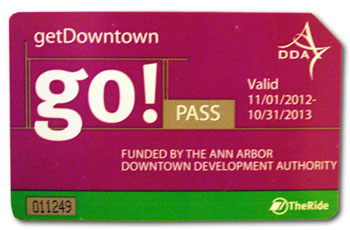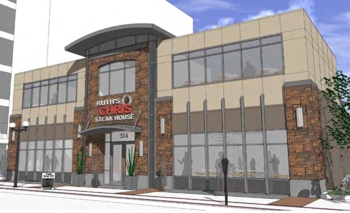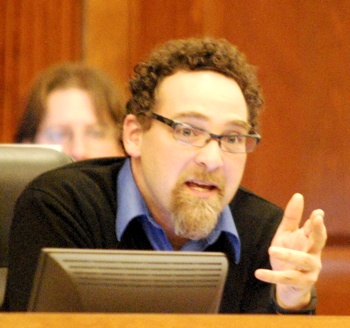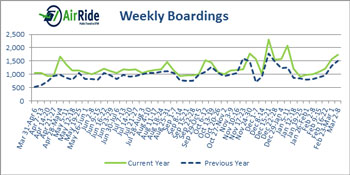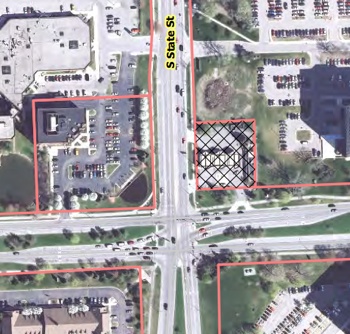The question of how the top of the Library Lane underground parking structure in downtown Ann Arbor will eventually be used has taken some steps toward getting answered. The city council acted on two key related resolutions at its March 17, 2014 meeting.
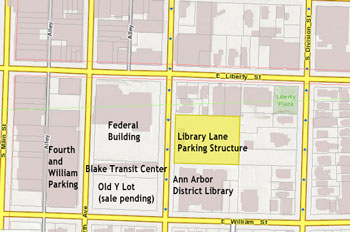
The Library Lane parking deck is highlighted in yellow. The name “Library Lane” is based only on the proximity of the structure to the downtown location of the Ann Arbor District Library. The library does not own the structure or the mid-block cut-through. (Base image from Washtenaw County and City of Ann Arbor GIS services.)
The council’s meeting actually featured three items related to the future of the Library Lane deck surface: (1) a resolution reserving part of the surface for a publicly owned urban park; (2) a resolution that moved toward hiring a brokerage service for selling development rights to the surface; and (3) a resolution that waived attorney-client privilege on a memo from the city’s outside bond counsel.
On the third item, the council voted to approve the waiver of an attorney-client privileged memo on the use of Build America Bonds that financed the parking deck.
The council vote on the urban park resolution was ultimately 7-3 with mayor John Hieftje, Christopher Taylor (Ward 3) and Margie Teall (Ward 4) dissenting. Sally Petersen (Ward 2) was absent. That came after a significant amendment to the resolution that gave flexibility to the square footage to be reserved instead of fixing it at 12,000 square feet. The key resolved clause, as adopted by the council, read:
Resolved, That City Council approve the reservation of the site for an urban public park of between approximately 6,500 and 12,000 square feet on the surface of the Library Lane Structure bounded by the Fifth Avenue sidewalk on the west, the Library Lane Street curb to the south, the western entry to the central elevator to the east, with the northern boundary to be determined at a future date;
The council’s vote came after public commentary from several speakers in support of the resolution. In addition, Ann Arbor District Library director Josie Parker was asked to the podium to comment and she read aloud a resolution that the library board had passed earlier that evening, opposing the council’s resolution.
A report on council deliberations, which lasted over 2.5 hours, is included in The Chronicle’s live updates from city hall during the March 17 meeting.
The resolution on reserving a portion of the surface of the Library Lane parking structure for a publicly-owned urban park had been postponed from the council’s March 3, 2014 meeting.

Library Lane park proposal as presented to the city’s park advisory commission on Feb. 25.
The proposal had been presented to the city’s park advisory commission, the week before the March 3 council meeting. For a detailed report of the PAC meeting of Feb. 25, 2014, see Chronicle coverage: “Concerns Voiced over Urban Park Proposal.”
One of the central points of friction over how to proceed is the question of who will own the area on which the publicly accessible space – a park or plaza – is placed.
The original resolution contemplated a publicly-owned facility that is designated as a park in the city’s park planning documents. That would have made it subject to a charter requirement on its sale – which would require a public referendum. The resolution as amended did not include that stipulation in its “resolved” clauses.
Councilmembers who are open to the possibility that the publicly accessible facility could be privately owned are concerned about the cost of maintenance of a publicly-owned facility. The city’s costs for maintaining Liberty Plaza – an urban park located northeast of the proposed Library Lane public park – are about $13,000 a year. That doesn’t include the amount that First Martin Corp. expends for trash removal and other upkeep of Liberty Plaza. [urban park cost estimates]
Revisions to the resolution were undertaken between the council’s March 3 and March 17 meetings. The version considered on March 17 indicated that the area designated as a park would be 12,000 square feet, compared to 10,000 square feet in the original resolution. That square footage reflects the actual dimensions of the proposed boundaries, according to a staff memo. That square footage was then revised at the meeting to “between approximately 6,500 and 12,000 square feet.” The revised resolution also eliminated an October 2014 deadline for making design recommendations to the council, and deleted any reference to PAC. [.pdf of revised resolution considered March 17 council meeting]
An additional point of friction involves how much of the site would be left for development if the northwest corner of the site were devoted to a public plaza/park. Related to that issue is whether the existing northern border of the site – which currently features the sides and backs of buildings – can adequately support a public plaza/park. The fact that the site does not currently enjoy other surrounding buildings that turn toward it is part of the reason advocates for a park are now asking that the Ann Arbor District Library, located to the south of the site, relocate its entrance from Fifth Avenue to the north side of its building. However, at the library board’s March 17 meeting, trustees on the board’s facilities committee reiterated reasons why they were not recommending to relocate the entrance.
In terms of the color-shaded map produced by city staff, the focus of controversy is the light orange area, which was designed to support “medium density building.” Based on staff responses to councilmember questions, the density imagined for that orange rectangle could be transferred to the planned high-density (red) portion of the site. The maximum height in the D1 zoning area is 180 feet, and the parking structure was designed to accommodate the structural load of an 18-story building.

City staff diagram illustrating the building possibilities for the top of the underground Library Lane parking structure.
Related to the urban park item was a resolution also approved at the March 17 meeting – to obtain brokerage services and to list the surface of the Library Lane deck for sale. It was brought forward by Stephen Kunselman (Ward 3).
The approach being taken would be similar to the path that the city council took to sell the former Y lot. For that parcel, the council directed the city administrator to move toward hiring a real estate broker to test the market for development rights. The council took the initial step with that property, located on William between Fourth and Fifth avenues in downtown Ann Arbor, close to a year ago at its March 4, 2013 meeting.
A rider agreement – to ensure against non-development and to sketch out the amount of open space and density – was part of the approach the city took to the former Y lot deal with hotelier Dennis Dahlmann.
The issue of open space figures prominently in Kunselman’s resolution. At the March 17 meeting, the council amended out the phrase “highest and best use” from the resolution. A key “whereas” clause and two of the “resolved” clauses read as follows:
Whereas, Developing the public space at the same time the site is developed will provide for increased activity, safety, and security; limit nuisance behavior at this public space; provide potential funding for public space features and programming; and have a responsible private entity for ongoing maintenance and
…
Resolved, That the City will seek, as conditions for development rights at a minimum, public open space, private maintenance of the public space, and pedestrian access to the public space as features of any private development;
Resolved, That implementation of the conditions for development rights will be determined by City Council through selection of the purchase offer that best responds to mixed-use, density, integration with surrounding uses, and public space and through the City’s established site plan procedures and policies;
The phrase “public space” sometimes is meant to include publicly-accessible, but privately-owned space. Kunselman responded to an emailed query about his intended interpretation of “public space” by writing: “It’s meant to give the broadest interpretation so as to solicit the widest range of interest by prospective purchasers.”
Also related to the council’s brokerage service resolution, the Ann Arbor planning commission agenda for March 18, 2014 includes a resolution giving advice to the council about how to handle the sale the parking deck surface. The two resolved clauses are:
Resolved, that the City Planning Commission recommends to City Council that if the development rights over the “Library Lot” underground parking structure are sold, an RFQ/RFP process be utilized that conditions the sale of the property in order to obtain a long-term, ongoing and growing economic benefit for the residents of the city;
Resolved, that the City Planning Commission recommends to City Council that if the development rights over the “Library Lot” underground parking structure are sold, an RFP contain some or all of the following conditions:
- A building that generates foot traffic, provides a human scale at the ground floor and creates visual appeal and contains active uses on all first floor street frontage and open space;
- A requirement for an entry plaza or open space appropriately scaled and located to be properly activated by adjacent building uses and to be maintained by the developer;
- A “mixed use” development with a density at around 700% FAR that takes advantage of the investment in footings and the mid-block location with active uses that have a high level of transparency fronting the plaza and at least 60% of Fifth Avenue and Library Lane frontages, while encouraging large floor plate office or lodging as a primary use, residential as a secondary use, and incorporating a cultural venue.
- A requirement for the entry plaza or open space to incorporate generous landscaping;
- A requirement that discourages surface parking, limits vehicular access for service areas to be located in alleys where available and prohibits service areas from being located on Fifth Avenue
- To seek an iconic design for this site that is visible on all four sides and that creates an iconic addition to the skyline;
- A requirement for high quality construction; and
- A request for a third party environmental certification (e.g., LEED Gold or Platinum)
The planning commission resolution is being brought forward by commissioners Diane Giannola and Bonnie Bona. It’s similar in intent to the recommendation that the commission gave to council regarding the sale of the former Y lot.
This brief was filed from the city council’s chambers on the second floor of city hall, located at 301 E. Huron.
